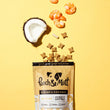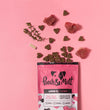FREE UK DELIVERY ON ORDERS OVER £39.99
Your puppy may be soft and fluffy to the touch right now, but sadly they don’t stay that way forever! All puppies shed their baby coats and go on to develop a coarser, more rugged coat to keep them protected as an adult. So, when does the shedding process start in puppies, and what can you expect from a puppy shedding their coat? Read on to get to grips with shedding early on, as your puppy develops their adult coat.
A coat is more than just fluff and cute aesthetics to a pup - it’s a big part of their identity, as well as providing warmth, protection and good health. When a puppy’s tiny, their coat is thinner and softer, as most of their protection comes from mum. As they grow, however, their burgeoning adult coat will define the dog’s breed and allow them to survive and keep warm on their own.
As a puppy grows, their coat will develop from the softer, thinner coat they were born with, to an adult coat that is coarser and thicker, and more representative of their breed. You’ll likely notice more dog hair on furniture and in your puppy’s bed, or it might come away in your hand when you pet them. The full shedding process can take up to two years in some breeds before their full adult coat comes in, and keeping a pup’s coat healthy during the shedding stages is very important.
Puppies shed over different lengths of time and at different rates, depending on a few factors:
So when will you know that your pup is about to let go of their old baby fur and grow a luscious adult coat? Shedding will make itself known in a few ways…
Puppies effectively start shedding as newborns, as the transitioning from puppy to adult coat involves a few stages…
At first your pooch will have a fetal coat, which is a thin, soft coat that protects them while they’re still in the womb. As they move out of the newborn stage, your pup sheds their fetal coat and develops a puppy coat, which eventually develops into their adult coat.
Their finished adult coat is usually thicker and coarser, may have an undercoat (if the breed is double-coated), and be brighter coloured than their puppy version. The full process can take time, and depending on your dog’s breed - their coat may go through a number of different textures before settling into its final state.
Shedding in short-haired breeds: Short-haired breeds such as Beagles and Boxers require less grooming maintenance - but can still shed quite significantly! Some short-haired breeds don’t lose quite as much fur as others, but it all depends on the breed.
Shedding in long-haired breeds: Long-haired breeds like Golden Retrievers and Afghan Hounds have beautiful locks and therefore see more substantial shedding. A regular grooming routine is needed to keep them from tangling or matting, and this is particularly important as your pup grows so they get accustomed to regular grooming.
Shedding in double-coated breeds: Double-coated breeds such as Huskies and German Shepherds have a dense undercoat beneath a longer outer coat. Their seasonal shedding process is sometimes called ‘blowing coat’, when they drop more fur in the spring or autumn seasons as they prepare for their summer or winter coat.
Puppies are going to shed, whether you want them to or not! It’s your responsibility as a puppy owner to help the process along, and to eventually integrate a thorough grooming routine that will keep their coat clean, comfortable and healthy as they age.
Here are some tips for keeping your pup’s coat in top condition as it sheds…
> Bathe pup regularly. Bathing your pup is essential to keeping their coat in good condition as it sheds and changes. Use a puppy formulated shampoo and massage gently into the fur. This will coax shedding hair to fall out easily and for the new fur to come in.
Note: Do not over bathe! Bathing more than monthly can lead to dry skin and fur, as the natural oils are washed away.
> Choose the right grooming tools. There are a ton of varied grooming tools out there - so be sure you get the right ones for your pup’s individual needs. Chat to a vet, groomer or pet store staff about the best tools for your dog’s breed and coat type.
> Be gentle. Remember your puppy is still young and easily harmed. They’re also getting used to grooming and everything the process involves. Be gentle when combing through fur or removing clumps of loose hair, and gently massage your dog’s skin to encourage fur turnover. Stay patient, and grooming your shedding pooch can even be an enjoyable bonding process.
> Be consistent. As above, it’s important for your pup to get used to being groomed at this early stage. Be consistent with combing and bathing, and they’ll hopefully be easier to manage at grooming time as they age into an adult dog.
Feeding your dog a nutritious, balanced diet is always the right choice, but when your puppy is developing and growing, the right food becomes more important than ever. Choose a healthy puppy food that contains coat-boosting ingredients such as omega-3 and 6 fatty acids (found in salmon and other oily fish), and high-quality lean proteins for puppies such as chicken and turkey. Keeping your pooch well hydrated is also mega important, to ensure a shiny, soft coat that turns heads on a dog walk.
It can be hard to know exactly whether your pup is shedding too much fur - but there are scenarios in which excessive shedding could be an indication of a problem. If you’ve noticed an increase in clumps of fur around the place, your dog is overly grooming themselves, or you can see bald patches, you should take them to the vet for a check-up.
By now you should be fully clued up on a puppy’s routine shedding ritual, but here are some final questions to round off the article.
Puppies will start shedding their puppy coats between 4 and 6 months old, so it’s completely normal for an 8-month old pup to shed. Dogs will shed a lot of fur throughout their lives - it’s up to you as a dog owner to schedule regular grooming sessions to help this process along and keep your pooch clean, tidy and beautifully coiffed.
You can introduce your pooch to the wonders of grooming from a very early age, using a soft brush - in fact, this will probably feel soothing to your pup and strengthen the bond between you. Talk to a vet about the best grooming tools and techniques for your puppy’s breed and coat stage.
Yep - all puppies shed their coats as the fur falls off and is renewed continually. To what extent they shed however, does depend on their breed and what kind of coat they develop as an adult dog. Some short-haired breeds won’t shed all that much, whereas a fluffy, long-haired breed will shed a lot, and need more frequent grooming.
Never miss a treat!
Subscribe to our newsletter and get blog articles amongst other treats delivered to your inbox




Comments (0)
Leave a comment